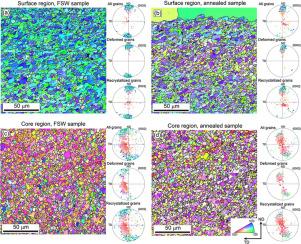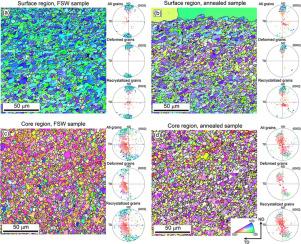揭示摩擦搅拌焊及退火AZ31合金搅拌区的非均匀性
IF 13.8
1区 材料科学
Q1 METALLURGY & METALLURGICAL ENGINEERING
引用次数: 0
摘要
采用扫描电镜(SEM)和电子背散射衍射(EBSD)测量了AZ31 (Mg-3Al-1Zn, wt.%)合金在搅拌摩擦焊(FSW)和400℃退火1 h后,表面和核心区域的组织和织构的差异。结果表明:FSW使晶粒细化,表面和芯部的平均晶粒尺寸分别从19 μm(母材)减小到5.1 μm和3.5 μm;由于工具肩的附加应变,表面区域晶粒的c轴与法向(<0001>//ND)对齐。而芯区则呈现出典型的剪切织构,c轴趋向于平行于焊接方向(<0001>//WD)。显微硬度图显示,由于动态再结晶和织构弱化,芯区比表面软化。退火处理后,SZ的显微组织基本保持形变,但表面上部出现了大量Mg17Al12析出相和少数<;11 ~ 20>;//WD取向晶粒的异常生长。表层晶粒c轴向WD方向倾斜约10°,核心区晶粒c轴向WD方向倾斜约30°。因此,显微硬度值在SZ上的分布比FSW样品更不均匀。从晶界取向偏差、位错密度和Mg17Al12相的钉住效应等方面对结果进行了讨论。此外,施密德因子分析用于检查基底滑移模式的激活,以表征相关的机械响应。本文章由计算机程序翻译,如有差异,请以英文原文为准。


Revealing stir zone heterogeneities in friction stir-welded and annealed AZ31 alloy
The difference in the microstructure, texture in the stir zone (SZ) of the AZ31 (Mg-3Al-1Zn, wt.%) alloy after friction stir welding (FSW) and subsequent annealing at 400 °C for 1 h was characterized by scanning electron microscopy (SEM) with electron backscatter diffraction (EBSD) measurements at the surface and core regions. The findings indicate that FSW produced grain refinement where the mean grain size decreases from 19 µm (base metal) to 5.1 and 3.5 µm at the surface and core regions, respectively. The c-axis of the grains at the surface region was aligned with the normal direction (<0001>//ND) due to the additional strain of the tool shoulder. In contrast, the core region shows a typical shear texture, where the c-axis tends to be oriented parallel to the welding direction (<0001>//WD). The Vickers microhardness mapping across the SZ revealed that the core region was soften than the surface region due to the dynamic recrystallization and texture weakening. The microstructure of the SZ remains principally deformed after annealing treatment except for the development of massive Mg17Al12 precipitates and the abnormal grain growth of a few grains with <11−20>//WD orientation at the upper side of the surface region. The c-axis of the grains at the surface region was tilted about 10° toward WD, while an inclined <0001>//WD orientation about 30° from WD was developed at the core region. Consequently, the distribution of microhardness values across the SZ was more heterogeneous than the FSW sample. The results were discussed in the light of grain boundary misorientation, dislocation density and the pinning effect of Mg17Al12 precipitates. Additionally, Schmid factor analysis was used to examine the activation of the basal slip mode to characterize the associated mechanical response.
求助全文
通过发布文献求助,成功后即可免费获取论文全文。
去求助
来源期刊

Journal of Magnesium and Alloys
Engineering-Mechanics of Materials
CiteScore
20.20
自引率
14.80%
发文量
52
审稿时长
59 days
期刊介绍:
The Journal of Magnesium and Alloys serves as a global platform for both theoretical and experimental studies in magnesium science and engineering. It welcomes submissions investigating various scientific and engineering factors impacting the metallurgy, processing, microstructure, properties, and applications of magnesium and alloys. The journal covers all aspects of magnesium and alloy research, including raw materials, alloy casting, extrusion and deformation, corrosion and surface treatment, joining and machining, simulation and modeling, microstructure evolution and mechanical properties, new alloy development, magnesium-based composites, bio-materials and energy materials, applications, and recycling.
 求助内容:
求助内容: 应助结果提醒方式:
应助结果提醒方式:


